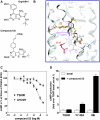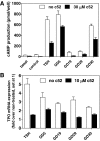A low-molecular-weight antagonist for the human thyrotropin receptor with therapeutic potential for hyperthyroidism
- PMID: 18669595
- PMCID: PMC2613050
- DOI: 10.1210/en.2008-0836
A low-molecular-weight antagonist for the human thyrotropin receptor with therapeutic potential for hyperthyroidism
Abstract
Low-molecular-weight (LMW) antagonists for TSH receptor (TSHR) may have therapeutic potential as orally active drugs to block stimulating antibodies (TsAbs) in Graves' hyperthyroidism. We describe an approach to identify LMW ligands for TSHR based on Org41841, a LMW partial agonist for the LH/choriogonadotropin receptor and TSHR. We used molecular modeling and functional experiments to guide the chemical modification of Org41841. We identified an antagonist (NIDDK/CEB-52) that selectively inhibits activation of TSHR by both TSH and TsAbs. Whereas initially characterized in cultured cells overexpressing TSHRs, the antagonist was also active under more physiologically relevant conditions in primary cultures of human thyrocytes expressing endogenous TSHRs in which it inhibited TSH- and TsAb-induced up-regulation of mRNA transcripts for thyroperoxidase. Our results establish this LMW compound as a lead for the development of higher potency antagonists and serve as proof of principle that LMW ligands that target TSHR could serve as drugs in patients with Graves' disease.
Figures


Comment in
-
Antithyroid drugs are 65 years old: time for retirement?Endocrinology. 2008 Dec;149(12):5943-4. doi: 10.1210/en.2008-1349. Endocrinology. 2008. PMID: 19022900 No abstract available.
Similar articles
-
Update in TSH receptor agonists and antagonists.J Clin Endocrinol Metab. 2012 Dec;97(12):4287-92. doi: 10.1210/jc.2012-3080. Epub 2012 Sep 27. J Clin Endocrinol Metab. 2012. PMID: 23019348 Free PMC article. Review.
-
Thyrotropin, but Not Thyroid-Stimulating Antibodies, Induces Biphasic Regulation of Gene Expression in Human Thyrocytes.Thyroid. 2020 Feb;30(2):270-276. doi: 10.1089/thy.2019.0418. Epub 2020 Jan 28. Thyroid. 2020. PMID: 31805824 Free PMC article.
-
Antithyroid drugs are 65 years old: time for retirement?Endocrinology. 2008 Dec;149(12):5943-4. doi: 10.1210/en.2008-1349. Endocrinology. 2008. PMID: 19022900 No abstract available.
-
A small molecule inverse agonist for the human thyroid-stimulating hormone receptor.Endocrinology. 2010 Jul;151(7):3454-9. doi: 10.1210/en.2010-0199. Epub 2010 Apr 28. Endocrinology. 2010. PMID: 20427476 Free PMC article.
-
Insight into Graves' hyperthyroidism from animal models.Endocr Rev. 2005 Oct;26(6):800-32. doi: 10.1210/er.2004-0023. Epub 2005 Apr 12. Endocr Rev. 2005. PMID: 15827111 Review.
Cited by
-
Potential Roles of CD34+ Fibrocytes Masquerading as Orbital Fibroblasts in Thyroid-Associated Ophthalmopathy.J Clin Endocrinol Metab. 2019 Feb 1;104(2):581-594. doi: 10.1210/jc.2018-01493. J Clin Endocrinol Metab. 2019. PMID: 30445529 Free PMC article. Review.
-
Discovery and Development of Small Molecule Allosteric Modulators of Glycoprotein Hormone Receptors.Front Endocrinol (Lausanne). 2015 Sep 14;6:142. doi: 10.3389/fendo.2015.00142. eCollection 2015. Front Endocrinol (Lausanne). 2015. PMID: 26441832 Free PMC article. Review.
-
TSHR as a therapeutic target in Graves' disease.Expert Opin Ther Targets. 2017 Apr;21(4):427-432. doi: 10.1080/14728222.2017.1288215. Epub 2017 Feb 6. Expert Opin Ther Targets. 2017. PMID: 28127991 Free PMC article. Review.
-
Update in TSH receptor agonists and antagonists.J Clin Endocrinol Metab. 2012 Dec;97(12):4287-92. doi: 10.1210/jc.2012-3080. Epub 2012 Sep 27. J Clin Endocrinol Metab. 2012. PMID: 23019348 Free PMC article. Review.
-
Signaling-sensitive amino acids surround the allosteric ligand binding site of the thyrotropin receptor.FASEB J. 2010 Jul;24(7):2347-54. doi: 10.1096/fj.09-149146. Epub 2010 Feb 23. FASEB J. 2010. PMID: 20179143 Free PMC article.
References
-
- Ascoli M, Fanelli F, Segaloff DL 2002 The lutropin/choriogonadotropin receptor, a 2002 perspective. Endocr Rev 23:141–174 - PubMed
-
- Szkudlinski MW, Fremont V, Ronin C, Weintraub BD 2002 Thyroid-stimulating hormone and thyroid-stimulating hormone receptor structure-function relationships. Physiol Rev 82:473–502 - PubMed
-
- Vassart G, Pardo L, Costagliola S 2004 A molecular dissection of the glycoprotein hormone receptors. Trends Biochem Sci 29:119–126 - PubMed
-
- Guo T 2005 Small molecule agonists and antagonists for the LH and FSH receptors. Expert Opin Ther Patents 15:1555–1564
Publication types
MeSH terms
Substances
Grants and funding
LinkOut - more resources
Full Text Sources
Other Literature Sources
Medical

